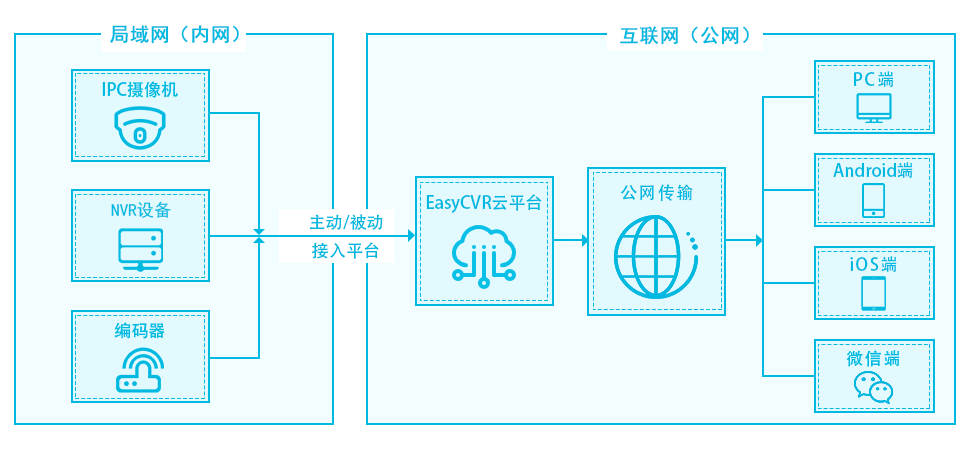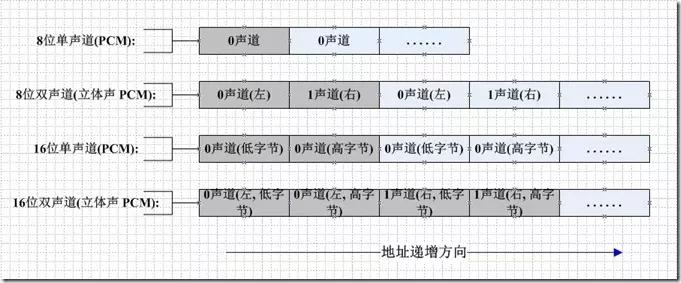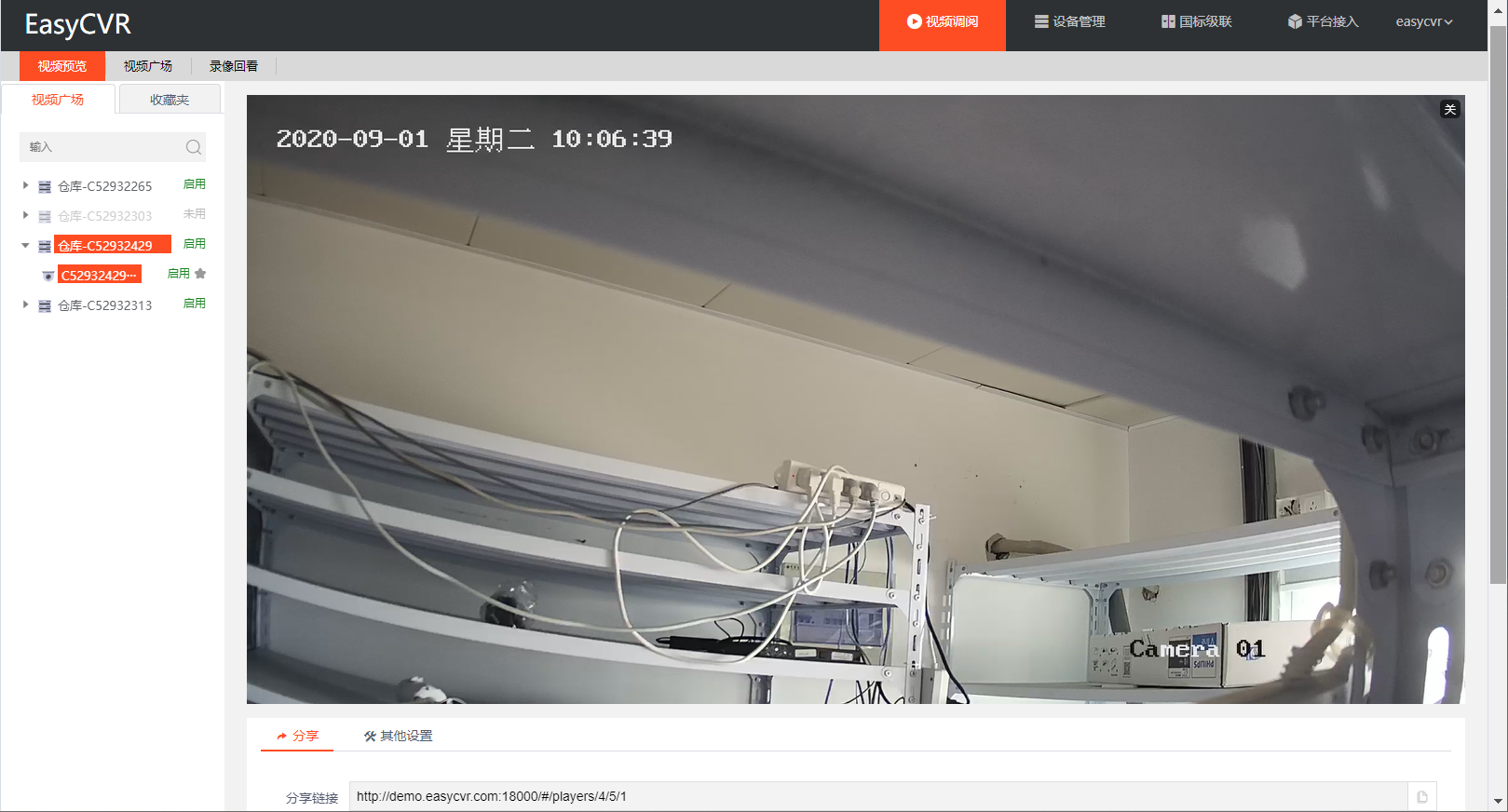EasyCVR是TSINGSEE青犀视频研发的视频上云网关,设备端有公网IP,可通过海康SDK、Onvif/RTSP、GB28181、ehome协议接入到EasyCVR中;设备端无公网IP,可通过GB28181、ehome协议接入到EasyCVR中,也可在内网安装EasyNTS设备,与公网建立传输通道,这样即可通过海康SDK、Onvif/RTSP接到EasyCVR中。

本文和大家讲一下EasyCVR中关于音频的一些知识,都是研发在编译当中用到的,大家可以简单了解一下。
> ffplay -i test.pcm -f s16le -ac 1 -ar 8000 > ffplay -i test.g711a -f alaw -ac 1 -ar 8000 > ffplay -i test.g711u -f mulaw -ac 1 -ar 8000
注意:ac 通道 ar 采样率设置对
-i 指定要播放的文件
-f 编码格式
-ac 通道数
-ar 采样率
采样率16KHZ,位宽16bit,双声道,1分钟采集数据的大小
160002260/1024/1024
采样率16KHZ,位宽32bit,双声道,1分钟采集数据的大小
160004260/1024/1024
采样率16KHZ,位宽16bit,单声道,1分钟采集数据的大小
160002160/1024/1024
采样率16KHZ,位宽8bit,单声道,1分钟采集数据的大小
160001160/1024/1024
例如:16000Hz 表示1s中在连续信号中采集16000次,每一次叫做一个采样点
例如:16bit 表示每一个采样点采集2个byte的数据,也就是2个字节

#define BIAS (0x84) /* Bias for linear code. */
/*
* linear2ulaw() - Convert a linear PCM value to u-law
*
* In order to simplify the encoding process, the original linear magnitude
* is biased by adding 33 which shifts the encoding range from (0 - 8158) to
* (33 - 8191). The result can be seen in the following encoding table:
*
* Biased Linear Input Code Compressed Code
* ------------------------ ---------------
* 00000001wxyza 000wxyz
* 0000001wxyzab 001wxyz
* 000001wxyzabc 010wxyz
* 00001wxyzabcd 011wxyz
* 0001wxyzabcde 100wxyz
* 001wxyzabcdef 101wxyz
* 01wxyzabcdefg 110wxyz
* 1wxyzabcdefgh 111wxyz
*
* Each biased linear code has a leading 1 which identifies the segment
* number. The value of the segment number is equal to 7 minus the number
* of leading 0's. The quantization interval is directly available as the
* four bits wxyz. * The trailing bits (a - h) are ignored.
*
* Ordinarily the complement of the resulting code word is used for
* transmission, and so the code word is complemented before it is returned.
*
* For further information see John C. Bellamy's Digital Telephony, 1982,
* John Wiley & Sons, pps 98-111 and 472-476.
*/
unsigned char
linear2ulaw(
int pcm_val) /* 2's complement (16-bit range) */
{
int mask;
int seg;
unsigned char uval;
/* Get the sign and the magnitude of the value. */
if (pcm_val < 0) {
pcm_val = BIAS - pcm_val;
mask = 0x7F;
} else {
pcm_val += BIAS;
mask = 0xFF;
}
/* Convert the scaled magnitude to segment number. */
seg = search(pcm_val, seg_end, 8);
/*
* Combine the sign, segment, quantization bits;
* and complement the code word.
*/
if (seg >= 8) /* out of range, return maximum value. */
return (0x7F ^ mask);
else {
uval = (seg << 4) | ((pcm_val >> (seg + 3)) & 0xF);
return (uval ^ mask);
}
}
/*
* ulaw2linear() - Convert a u-law value to 16-bit linear PCM
*
* First, a biased linear code is derived from the code word. An unbiased
* output can then be obtained by subtracting 33 from the biased code.
*
* Note that this function expects to be passed the complement of the
* original code word. This is in keeping with ISDN conventions.
*/
int
ulaw2linear(
unsigned char u_val)
{
int t;
/* Complement to obtain normal u-law value. */
u_val = ~u_val;
/*
* Extract and bias the quantization bits. Then
* shift up by the segment number and subtract out the bias.
*/
t = ((u_val & QUANT_MASK) << 3) + BIAS;
t <<= ((unsigned)u_val & SEG_MASK) >> SEG_SHIFT;
return ((u_val & SIGN_BIT) ? (BIAS - t) : (t - BIAS));
}
/* A-law to u-law conversion */
unsigned char
alaw2ulaw(
unsigned char aval)
{
aval &= 0xff;
return ((aval & 0x80) ? (0xFF ^ _a2u[aval ^ 0xD5]) :
(0x7F ^ _a2u[aval ^ 0x55]));
}
/* u-law to A-law conversion */
unsigned char
ulaw2alaw(
unsigned char uval)
{
uval &= 0xff;
return ((uval & 0x80) ? (0xD5 ^ (_u2a[0xFF ^ uval] - 1)) :
(0x55 ^ (_u2a[0x7F ^ uval] - 1)));
}
EasyCVR播放界面

EasyCVR支持阿里云、腾讯云、华为云、七牛云等,支持S3和Swift接口的对象存储服务,简单配置,部署更高效;且支持传统网络摄像机、NVR、编码器、SDK等设备,最大程度的提高了硬件设备的兼容性。
视频相关解决方案均可访问TSINGSEE青犀视频,可以联系我们获取演示方案,直观感受,也可自行下载及测试。